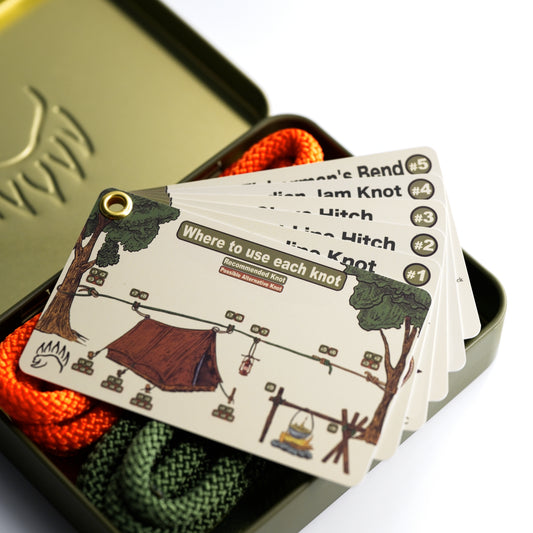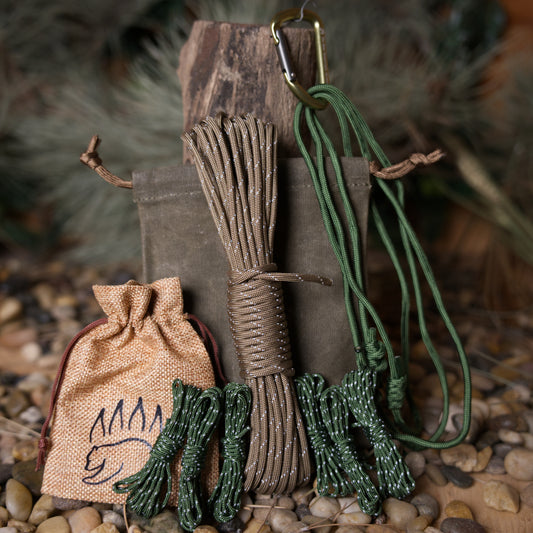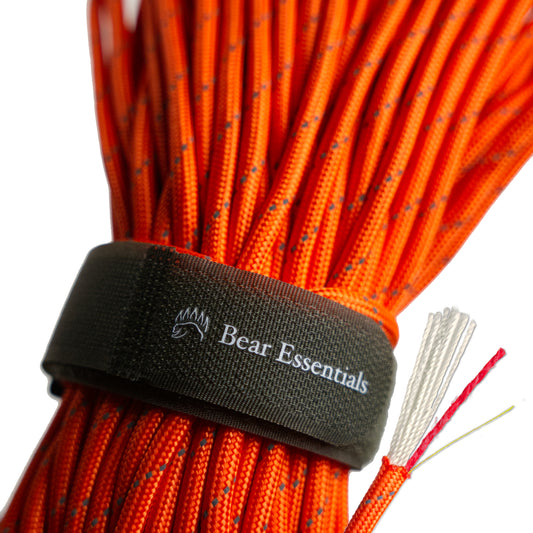How to Tie the Trucker’s Hitch - Alpine Butterfly Variation
Usage
The Trucker’s Hitch - Alpine Butterfly Variation is commonly used to tension ropes for securing loads, like tarps or gear. Compared to other tackle knots, such as the Poldo Tackle, or the Slipknot version of the Trucker’s Hitch, it offers a non-jamming loop that’s easier to untie after heavy strain. Its pulley-like system provides strong tension, but it takes practice to tie smoothly. It’s a favourite for camping setups, especially for wind-resistant shelters. The main downside is needing enough rope length for the loop and anchor.
Why Learn the Trucker’s Hitch - Alpine Butterfly Variation?
- Non-jamming loop: The Alpine Butterfly loop stays easy to untie after heavy loads.
- High tension: Offers a 3:1 mechanical advantage for tightening ropes securely.
- Versatile use: Ideal for tarps, shelters, or hauling gear in rugged settings.
- Rope-friendly: Spreads stress evenly, reducing wear compared to slip knot versions.
- Quick adjustment: Fine-tune tension without retying the whole knot.
Common Uses
-
Scouts:
- Secures gear for pioneering projects.
- Tensions ropes for camp setups.
-
Search and Rescue:
- Hauls equipment in high-angle operations.
- Secures litters for stable transport.
-
Camping:
- Tightens tarps for wind-resistant shelters.
- Ties guylines to stakes for tents.
-
Bushcraft:
- Hangs food bags out of reach.
- Builds sturdy shelters with taut lines.
ABOK Number
(Ashley Book of Knots)
Other Names
Category
|
How to Tie the Trucker’s Hitch - Alpine Butterfly Variation
- Step 1: Tie an Alpine Butterfly loop mid-rope by twisting the rope twice, threading the second loop through the first, and pulling tight.
- Step 2: Pass the working end through an anchor point, like a stake or tree.
- Step 3: Bring the working end back and thread it through the Alpine Butterfly loop.
- Step 4: Pull the working end to tighten the system, creating tension.
- Step 5: Secure the working end with two half hitches around the standing line.
Tips:
- Make sure the Alpine Butterfly loop is snug before loading to avoid slipping.
- Use a smooth rope to reduce friction when tightening.
- Practice tying the loop quickly for efficiency in the field.
Variations
Trucker’s Hitch - Double Dragon Variation vs. Trucker’s Hitch - Alpine Butterfly Variation
- Pros: Resists jamming and aligns better for in-line pulls.
- Cons: Slightly harder to tie and less familiar to most users.
Trucker’s Hitch - Prusik Variation vs. Trucker’s Hitch - Alpine Butterfly Variation
- Pros: Allows sliding the loop along the rope for precise positioning.
- Cons: Needs a separate cord for the Prusik, adding complexity.
Similar Knots
Trucker’s Hitch - Slipknot Variation vs. Trucker’s Hitch - Alpine Butterfly Variation
- Pros: Quick to tie and widely used for basic tensioning.
- Cons: Slip knot binds tightly, making it hard to untie after heavy loads.
Poldo Tackle vs. Trucker’s Hitch - Alpine Butterfly Variation
- Pros: Offers adjustable loops for dynamic tensioning.
- Cons: Less intuitive and requires more rope than the Alpine Butterfly version.
History and Origins
The Trucker’s Hitch has roots in maritime and overland transport, where securing cargo was critical for sailors and teamsters. The Alpine Butterfly Variation likely developed in climbing and rescue settings, incorporating the non-jamming Alpine Butterfly loop, referenced in The Ashley Book of Knots (#1053) for its mid-line strength. Its use in modern bushcraft and camping highlights its adaptability for tensioning lines across outdoor scenarios.
Security Level
The Trucker’s Hitch - Alpine Butterfly Variation holds tension reliably under moderate to heavy loads without slipping when tied correctly. The Alpine Butterfly loop prevents binding, even after sustained strain. For slick ropes, extra wraps in the loop may improve grip. A stopper knot such as, the stevedore stopper knot, after the half hitches adds security for critical tasks.
Downsides
- Learning curve: Tying the Alpine Butterfly loop quickly takes practice.
- Rope length: Needs more rope than simpler hitches for the loop and anchor.
FAQ
Is the Trucker’s Hitch - Alpine Butterfly Variation strong enough for heavy loads?
Yes, it’s reliable for tarps, gear, or rescue hauling when tied correctly, but always check the rope and anchor.
What’s the best rope for the Trucker’s Hitch - Alpine Butterfly Variation?
A strong, low-stretch rope like nylon or polyester works best for secure tensioning.
How does the Trucker’s Hitch - Alpine Butterfly Variation compare to the slipknot version?
It’s easier to untie after heavy loads, unlike the slipknot, which can jam tightly.
Can the Trucker’s Hitch - Alpine Butterfly Variation be used for climbing?
It’s not typical for climbing anchors but works well for tensioning systems in climbing camps.
Why choose the Trucker’s Hitch - Alpine Butterfly Variation over a ratchet strap?
It’s lightweight, adjustable, and doesn’t need hardware, making it ideal for remote outdoor use.
Important Notes on Safety
- Common failure points include a poorly tied Alpine Butterfly loop or a weak anchor. Always verify the loop is snug and the anchor is solid before applying tension.
- Check the rope for wear before tying.
- Use at least two half hitches to lock the system.
- Practice tying in low-stakes settings first.









